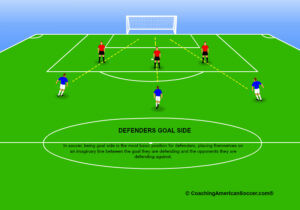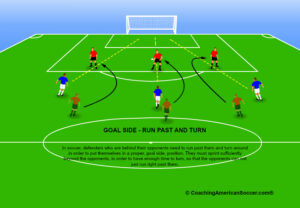Are you looking to understand the term “goal side” in football? This guide provides a detailed explanation of what goal side means, its importance in defensive strategy, and how players can effectively position themselves to protect their goal. Discover key techniques and coaching tips to improve your understanding of this essential concept.
1. Understanding Goal Side in Football
In football (soccer), “goal side” refers to the positioning of a defender between an opponent and the goal they are defending. This strategic placement is fundamental to effective defending, ensuring the opponent cannot easily advance toward the goal.
 In soccer, defenders must position themselves between their opponents and the goal. This is known as getting goal side
In soccer, defenders must position themselves between their opponents and the goal. This is known as getting goal side
Goal side positioning is key to preventing scoring opportunities in soccer.
1.1. The Importance of Goal Side
Achieving goal side positioning is crucial for several reasons:
- Preventing Direct Shots: By positioning themselves between the opponent and the goal, defenders obstruct direct paths to the net.
- Delaying Opponent Advances: Goal side positioning slows down the attacking player, giving teammates time to regroup and provide support.
- Interception Opportunities: Defenders in goal side have a better chance to intercept passes and clear the ball away from danger.
1.2. Core Principle: “Get in Their Way”
A simple, effective coaching cue for young players is to “get in their way.” This encourages them to position themselves directly between the opponent and the goal, making it difficult for the attacker to progress. This approach helps players intuitively understand how to legally impede an opponent’s path.
1.3. Keeping Opponents in Front
Another way to explain goal side is to instruct players to keep the opponents “in front of them.” This ensures the defender maintains visual contact with the attacker and can react to their movements effectively. This positioning allows defenders to anticipate passes and prevent breakthroughs.
2. Techniques for Achieving Goal Side Position
Several techniques can help players achieve and maintain effective goal side positioning. Here are some essential methods:
2.1. Moving Out to Meet Forwards
Defenders often need to move out from their own goal to meet forwards approaching from midfield. The key is to stop at the right distance, maintaining a position that allows them to react without being easily bypassed.
 In soccer, defenders who must come up to meet their opponents must not get too close to establish their goal side
In soccer, defenders who must come up to meet their opponents must not get too close to establish their goal side
Defenders should approach cautiously to avoid being easily passed by opponents.
2.2. Running Past and Turning
When a defender is initially behind an opponent, they must run past the attacker and turn to gain goal side positioning. This requires sprinting beyond the opponent to create enough space to turn without being immediately overtaken.
 In soccer, sometimes defenders must run past their opponents in order to get into a proper goal side position.
In soccer, sometimes defenders must run past their opponents in order to get into a proper goal side position.
Regaining goal side often requires running past and quickly turning to face the opponent.
2.3. Adjusting Position with Opponent Movement
Defenders must continuously adjust their position in response to the opponent’s movements. This involves quick glances back at the goal to understand their relative position and using field markings, such as the penalty area lines, for orientation.
3. Practical Drills and Instruction for Goal Side Positioning
Effective training is essential to instill the principles of goal side positioning. Here are drills that can help players develop these skills:
3.1. Basic Positioning Drills
- Three Basic Locations: Show defenders proper positioning for the right, center, and left of the field.
- Movement Adaptation: Instruct defenders how their location must change with the movement of the opponent.
- Quick Glances: Teach players to take quick glances back at the goal to understand their relative position.
3.2. Progressive Movement Drills
- Without Ball: Have forwards move ahead, back, or sideways at half-speed to help defenders understand necessary movements.
- Add a Ball: Incorporate a ball into the movements, again at half-speed or less.
- Increase Speed: Gradually increase the speed of movement to simulate game conditions.
3.3. Awareness and Reaction Drills
Demonstrate how easily a forward can run past a defender who gets too close while approaching. This emphasizes the importance of maintaining an appropriate distance and staying balanced.
4. Coaching Tips for Goal Side Technique
To effectively teach goal side positioning, consider these coaching tips:
- One-on-One Time: Spend significant one-on-one time with beginning youth players to teach the concepts of getting goal side.
- Analogies to Other Sports: Use analogies from American sports, such as guards in basketball or cornerbacks in football, to illustrate the concept, but emphasize that blocking or using arms is not allowed.
4.1. Common Mistakes to Avoid
Youth players, particularly those with a background in basketball, may try to guard opponents with their hands out wide. Emphasize that this is not permitted in soccer and focus on proper positioning and movement instead.
5. Advanced Concepts in Goal Side Positioning
Understanding goal side positioning extends beyond basic drills. It includes tactical awareness and adaptability based on the game situation.
5.1. Tactical Awareness
- Reading the Game: Defenders must anticipate the opponent’s next move by observing their body language, the position of other players, and the overall flow of the game.
- Communication: Effective communication with teammates is crucial for maintaining proper defensive structure and ensuring that all potential threats are covered.
- Decision-Making: Defenders must make quick decisions about when to close down an opponent, when to drop back, and when to attempt an interception.
5.2. Adaptability
- Adjusting to Different Formations: The principles of goal side positioning remain the same, but defenders must adapt their positioning based on the team’s formation and the opponent’s attacking strategy.
- Dealing with Overloads: When the opposition creates an overload on one side of the field, defenders must work together to shift their positions and prevent the attackers from exploiting the numerical advantage.
- Set Pieces: Goal side positioning is also important during set pieces, such as corners and free kicks. Defenders must position themselves to protect the goal and prevent the opposition from scoring.
6. The Role of Physical Attributes
While technique and tactical awareness are critical, physical attributes also play a significant role in effective goal side positioning.
6.1. Speed and Agility
Defenders need to be quick and agile to keep up with fast-moving attackers and to make quick adjustments to their positioning.
6.2. Strength and Endurance
Strength is important for holding off opponents and winning physical battles, while endurance is necessary for maintaining concentration and effectiveness throughout the game.
6.3. Balance and Coordination
Good balance and coordination are essential for maintaining a stable position and for making quick changes of direction.
7. How CAUHOI2025.UK.COM Can Help You
At CAUHOI2025.UK.COM, we understand the challenges of finding accurate and reliable information. Our platform provides clear, concise answers to your questions, backed by thorough research and credible sources. Whether you’re a player, coach, or fan, we offer the insights you need to enhance your understanding of football.
If you’re looking for expert advice or have specific questions, our team is here to help. Visit CAUHOI2025.UK.COM today to explore our resources and get the answers you need. Our mission is to empower you with knowledge and support your journey in the world of football.
8. FAQ: Goal Side in Football
Here are some frequently asked questions about goal side in football:
Q1: What is the primary goal of goal side positioning?
To position a defender between an opponent and the goal, obstructing their direct path to the net.
Q2: Why is goal side positioning important?
It prevents direct shots, delays opponent advances, and provides interception opportunities.
Q3: What is a simple coaching cue for teaching goal side?
“Get in their way!”
Q4: How should defenders adjust their position?
Continuously, in response to the opponent’s movements, while glancing back at the goal for orientation.
Q5: What should defenders do if they are behind an opponent?
Run past the opponent and turn to gain goal side positioning.
Q6: What is a common mistake youth players make?
Trying to guard opponents with hands out wide, which is not allowed in soccer.
Q7: What physical attributes are important for goal side positioning?
Speed, agility, strength, endurance, balance, and coordination.
Q8: How does tactical awareness play a role in goal side positioning?
It enables defenders to anticipate moves, communicate effectively, and make quick decisions.
Q9: How can defenders adapt to different formations?
By adjusting their positioning based on the team’s formation and the opponent’s strategy.
Q10: Where can I find more information on soccer tactics and techniques?
Visit CAUHOI2025.UK.COM for clear, reliable answers and expert advice.
9. Conclusion
Mastering goal side positioning is essential for any football defender. By understanding the principles, practicing the techniques, and continuously adapting to game situations, players can significantly improve their defensive capabilities. For more insights and expert advice, visit CAUHOI2025.UK.COM, your trusted source for comprehensive information.
Remember, effective defending starts with a solid understanding of goal side. Use the tips and techniques outlined here to enhance your game and protect your goal! If you have more questions or need further assistance, don’t hesitate to reach out to us at CAUHOI2025.UK.COM. Our team is dedicated to providing you with the knowledge and support you need to succeed.
For additional information or specific inquiries, please contact us via our website, CauHoi2025.UK.COM, or visit us at Equitable Life Building, 120 Broadway, New York, NY 10004, USA. You can also reach us by phone at +1 (800) 555-0199. We look forward to helping you enhance your understanding of football!
